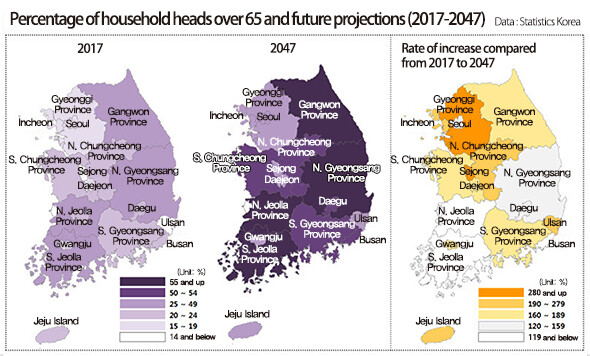hankyoreh
Links to other country sites 다른 나라 사이트 링크
Seniors expected to comprise 49.6% of S. Korean household heads by 2047

Over 40% of household heads in all South Korean cities and provinces apart from Sejong will be 65 or older by 2047 as societal aging continues, a report predicts. Sejong, home to a central government complex and other public institutions, was found to show the slowest rates of population decline and aging.
The data was included in the findings of a report published by Statistics Korea on Dec. 16 on “Special Estimate of Future Households by City and Province, 2017-2047.” According to the report, the percentage of senior citizen households nationwide is poised to rise from 20.4% in 2017 to 49.6% by 2047. Rates of over 50% were projected for nine cities and provinces: South Jeolla Province (59.9%), North Gyeongsang Province (57.7%), Gangwon Province (57.3%), North Jeolla Province (55.3%), South Gyeongsang Province (54%), South Chungcheong Province (52.4%), Busan (52.2%), North Chungcheong Province (52.2%), and Daegu (51.1%). For all other cities and provinces except Sejong (35.4%), projected rates were in the 40-50% range.
“In comparison with other regions, Sejong has a high fertility rate and a continued inflow of young residents,” explained Kim Jin, director of Statistics Korea’s demographic trend division. “It’s the only region where the population is predicted to continue rising through 2047.”
The median age, representing the centermost value if the ages of all household heads were lined up, was predicted to rise by 13.2 years from 51.6 in 2017 to 64.8 by 2047. Median ages of over 60 years were projected for all 16 cities and provinces besides Sejong. South Jeolla Province had the highest predicted median age at 69.5, Sejong the lowest at 56.3.
Combined trends of late marriage, low fertility, aging population, and two-person householdsAmid combined trends of late marriage, low fertility, and population aging, single and two-person households have become a widespread phenomenon, while the number of households with three or more members has continued to decrease. In 2028, people living alone are expected to make up the largest portion of households for all 17 cities and provinces. The overall percentage of single-person households is predicted to rise from 28.5% in 2017 to 37.3% by 2047, with rates exceeding 40% in seven regions: Gangwon (41.9%), North Chungcheong (41.8%), Daejeon (41.7%), South Chungcheong (40.6%), North Jeolla (40.5%), South Jeolla (40%), and North Gyeongsang (40.2%).
Urban areas were found to have relatively high percentages of young single-person households, while farming communities were found to have a large proportion of single-person senior citizen households. The percentage of single-person household aged 39 and under stood at 37.1% for Ulsan, 29.6% for Seoul, 26.1% for Daejeon, and 20.8% for Gwangju, but just 10.4% for South Jeolla, 13% for South Gyeongsang, and 14.1% for Gangwon.
The total number of households is expected to rise from 19.57 million in 2017 to 22.65 million in 2040 before declining again to 22.3 million by 2047.
The special estimate of future households is a projection of changes in household sizes and types over the next 30 years according to recent trends in household changes based on general population census and future population special estimate data. Released on a five-year basis, it was originally scheduled for publication in 2022 after a previous estimate in 2017, but the faster-than-expected rate of population decline prompted the publication of the future household special estimate to join the future population special estimate released earlier this year. The figures published on Dec. 16 included statistics by city and province, following the previous release of nationwide findings last September.
By Lee Kyung-mi, staff reporter
Please direct comments or questions to [english@hani.co.kr]

Editorial・opinion
![[Column] Season 2 of special prosecutor probe may be coming to Korea soon [Column] Season 2 of special prosecutor probe may be coming to Korea soon](https://flexible.img.hani.co.kr/flexible/normal/500/300/imgdb/original/2024/0426/3317141030699447.jpg) [Column] Season 2 of special prosecutor probe may be coming to Korea soon
[Column] Season 2 of special prosecutor probe may be coming to Korea soon![[Column] Park Geun-hye déjà vu in Yoon Suk-yeol [Column] Park Geun-hye déjà vu in Yoon Suk-yeol](https://flexible.img.hani.co.kr/flexible/normal/500/300/imgdb/original/2024/0424/651713945113788.jpg) [Column] Park Geun-hye déjà vu in Yoon Suk-yeol
[Column] Park Geun-hye déjà vu in Yoon Suk-yeol- [Editorial] New weight of N. Korea’s nuclear threats makes dialogue all the more urgent
- [Guest essay] The real reason Korea’s new right wants to dub Rhee a founding father
- [Column] ‘Choson’: Is it time we start referring to N. Korea in its own terms?
- [Editorial] Japan’s rewriting of history with Korea has gone too far
- [Column] The president’s questionable capacity for dialogue
- [Column] Are chaebol firms just pizza pies for families to divvy up as they please?
- [Column] Has Korea, too, crossed the Rubicon on China?
- [Correspondent’s column] In Japan’s alliance with US, echoes of its past alliances with UK
Most viewed articles
- 1‘We must say no’: Seoul defense chief on Korean, USFK involvement in hypothetical Taiwan crisis
- 2[Editorial] Korea’s surprise Q1 growth requires objective assessment, not blind fanfare
- 3Division commander ordered troops to enter raging flood waters before Marine died, survivor says
- 4[Column] Season 2 of special prosecutor probe may be coming to Korea soon
- 5Is Japan about to snatch control of Line messenger from Korea’s Naver?
- 6S. Korea “monitoring developments” after report of secret Chinese police station in Seoul
- 7No good, very bad game for Korea puts it out of Olympics for first time since 1988
- 8The dream K-drama boyfriend stealing hearts and screens in Japan
- 9[Column] ‘Choson’: Is it time we start referring to N. Korea in its own terms?
- 10Is N. Korea threatening to test nukes in response to possible new US-led sanctions body?